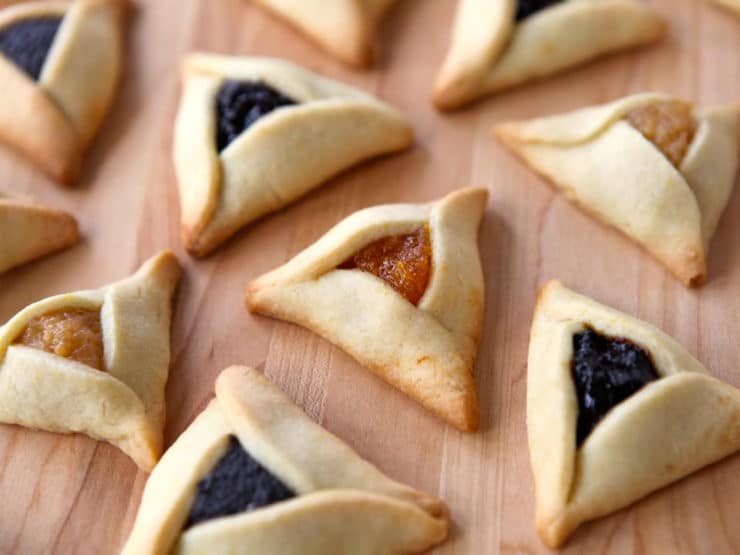
It’s that time of year again… time to break out the bakeware and get into a “triangular” state of mind! The Jewish holiday of Purim is all about triangle-shaped foods– classic Jewish baked goodies like bourekas, sambusak, and of course hamantaschen cookies. In the story of Purim, it is said that the villain Haman wore a triangular hat everywhere he went. Triangular foods like hamantaschen have three corners to represent Haman’s hat. My husband grew up in Israel calling these cookies oznei haman, which translates from Hebrew to “Haman’s ears.”Apparently, in some versions of the story, haman has triangular ears. There is also a theory out there that Haman had triangular pockets, since the word hamantaschen literally translates from Yiddish as “Haman’s pockets” (I tend to think the translation has more to do with the fact that these cookies are filled, like little pockets of dough). A more poetic interpretation links the three corners of the triangle shape to the three founding fathers of Judaism—Abraham, Isaac, and Jacob. Whatever the reason, it’s traditional to eat triangular foods like hamantaschen on Purim… so eat them we must!
I hit upon this Dairy Free Hamantaschen recipe after a few years of experimenting in the kitchen, searching for a foolproof hamantaschen dough. I’m a perfectionist, so my go-to dough needs to be absolutely perfect! I had a long list of criteria for the dough. I wanted it to have the following qualities:
– Easy to roll out
– Easy to shape
– Won’t expand/open around the filling when baked
– Does not include margarine or shortening
– Bakes up delicate with a nice texture (not heavy)
– Wonderful flavor that will compliment any kind of sweet filling
This dough satisfies all the criteria… it is truly a wonderful dough. It does not require refrigeration before rolling out. It’s also very easy to work with– the “feel” of the dough is terrific. It’s the best texture I’ve developed for rolling and shaping. Most importantly, it creates the tastiest hamantaschen ever. My family is in love with these cookies!
You can use any hamantaschen filling you like with this dough; I’ve linked to the filling recipes available on my site below (both dairy and non-dairy fillings). The key to a good filling is to make sure it is thick enough to prevent running, but not so thick that it bakes up dry or tough. All of these filling recipes are tasty, and they all have the proper texture for use in hamantaschen. I will update this list of fillings as I add new ones to the site.
Hamantaschen Fillings
Rabbi Olitzky’s Chocolate Chip Cream Cheese Filling
Prefer a butter-based hamantaschen dough? Click here for my Buttery Hamantaschen recipe. To learn more about the holiday of Purim, click here.
Recommended Products:
We are a participant in the Amazon Services LLC Associates Program, an affiliate advertising program designed to provide a means for us to earn fees by linking to Amazon.com and affiliated sites. As an Amazon Associate I earn from qualifying purchases.
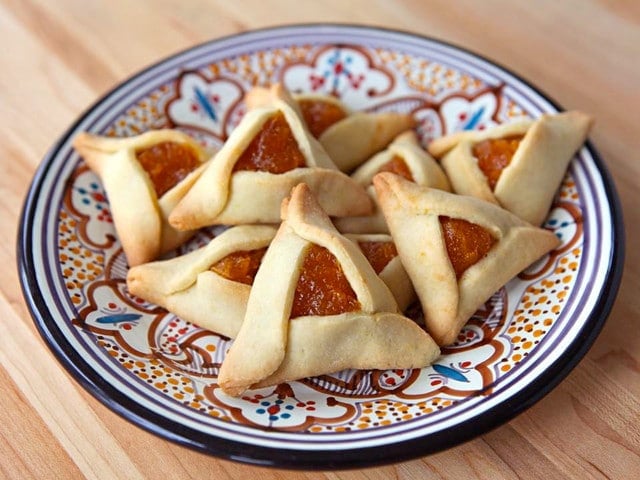
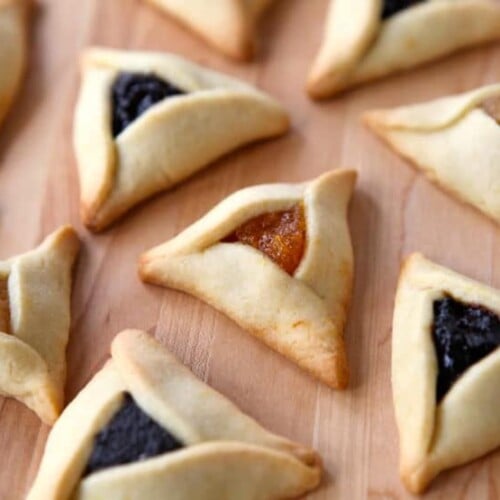
Dairy Free Hamantaschen
Ingredients
- 2 large eggs
- 2/3 cup sugar
- 1/4 cup canola oil
- 1 teaspoon orange zest
- 1 teaspoon vanilla
- 2 1/4 cups flour
- 1 teaspoon baking powder
- 1/4 teaspoon salt
- 1-5 teaspoons water (if needed)
- Nonstick cooking oil spray
NOTES
Instructions
- Before you begin making the hamantaschen, choose and make your filling and have it on hand to work with. This dough will dry out quickly if left to rest too long, so it's best to have everything ready to assemble when you start.Preheat your oven to 350 degrees F. In a mixing bowl, whisk together the eggs, sugar, canola oil, orange zest and vanilla.

- In another bowl, sift together the flour, baking powder, and salt.

- Slowly stir the dry ingredients into the wet, using a large wooden spoon and using circular motions until a crumbly dough begins to form.

- Knead until smooth and slightly tacky to the touch. Try not to overwork the dough, only knead till the dough is the right consistency. If the crumbles are too dry to form a smooth dough, add water slowly, 1 teaspoon at a time, using your hands to knead the liquid into the dough. Knead and add liquid until the dough is smooth and slightly tacky to the touch (not sticky), with a consistency that is right for rolling out. It can easily go from the right consistency to too wet/sticky, so add water very slowly. If the dough seems too wet, knead in a little flour until it reaches the right texture.

- Lightly flour a smooth, clean surface. Use a rolling pin to roll the dough out to 1/4 inch thick. Scrape the dough up with a pastry scraper, lightly reflour the surface, and flip the dough over. Continue rolling the dough out very thin (less than 1/8 of an inch thick). The thinner you roll the dough, the more delicate and crisp the cookies will turn out-- just make sure that the dough is still thick enough to hold the filling and its shape! If you prefer a thicker, more doughy texture to your cookies (less delicate), keep the dough closer to 1/4 inch thick. Lightly flour the rolling pin occasionally to prevent sticking, if you need to.

- Use a 3-inch cookie cutter (not smaller) or the 3-inch rim of a glass to cut circles out of the dough, cutting as many as you can from the dough.Gather the scraps and roll them out again. Cut circles. Repeat process again if needed until you've cut as many circles as you can from the dough. You should end up with around 35 circles.

- Place a teaspoon of filling (whichever filling you choose) into the center of each circle. Do not use more than a teaspoon of filling, or you run the risk of your hamantaschen opening and filling spilling out during baking. Cover unused circles with a lightly damp towel to prevent them from drying out while you are filling.

- Assemble the hamantaschen in three steps. First, grasp the left side of the circle and fold it towards the center to make a flap that covers the left third of the circle.

- Grasp the right side of the circle and fold it towards the center, overlapping the upper part of the left side flap to create a triangular tip at the top of the circle. A small triangle of filling should still be visible in the center.

- Grasp the bottom part of the circle and fold it upward to create a third flap and complete the triangle. When you fold this flap up, be sure to tuck the left side of this new flap underneath the left side of the triangle, while letting the right side of this new flap overlap the right side of the triangle. This way, each side of your triangle has a corner that folds over and a corner that folds under-- it creates a "pinwheel" effect. This method if folding is not only pretty-- it will help to keep the cookies from opening while they bake.

- Pinch each corner of the triangle gently but firmly to secure the shape.Repeat this process for the remaining circles.

- When all of your hamantaschen have been filled, place them on a lightly greased baking sheet, evenly spaced. You can fit about 20 on one sheet... they don't need to be very spaced out because they shouldn't expand much during baking.Place them in the oven and let them bake at 350 degrees F for 20-25 minutes, until the cookies are cooked through and lightly golden.

- Cool the cookies on a wire rack. Store them in a tightly sealed plastic bag or Tupperware.

Nutrition

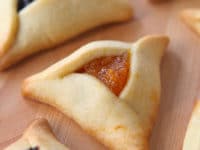
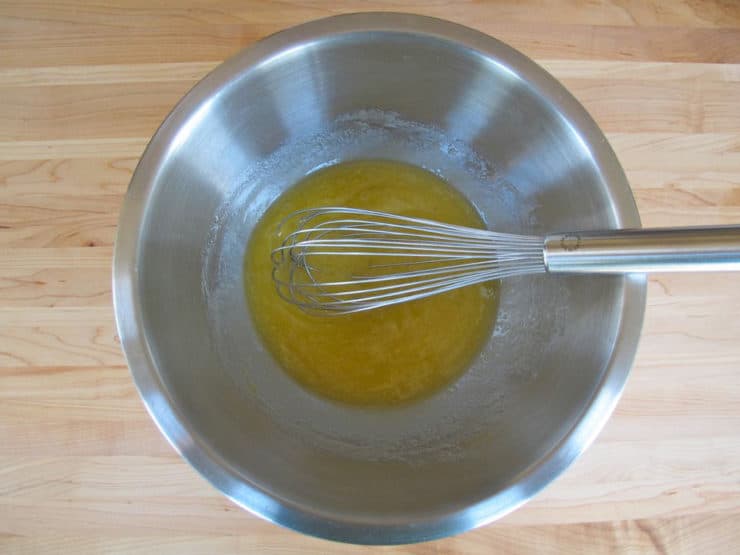
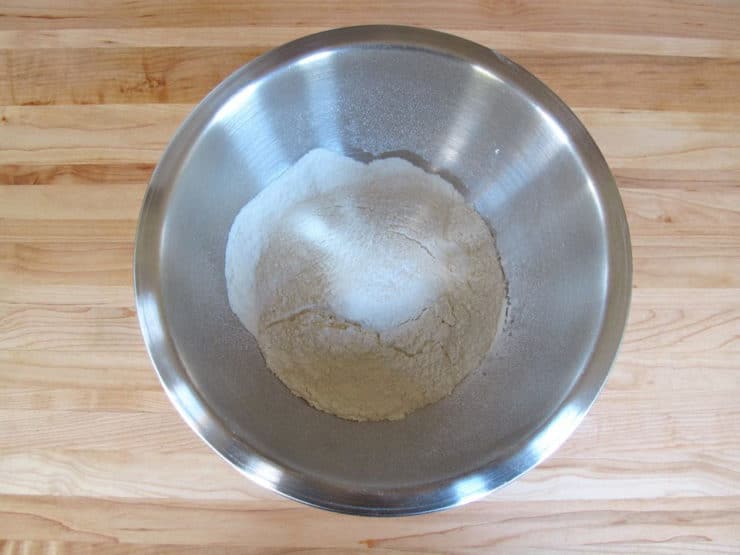
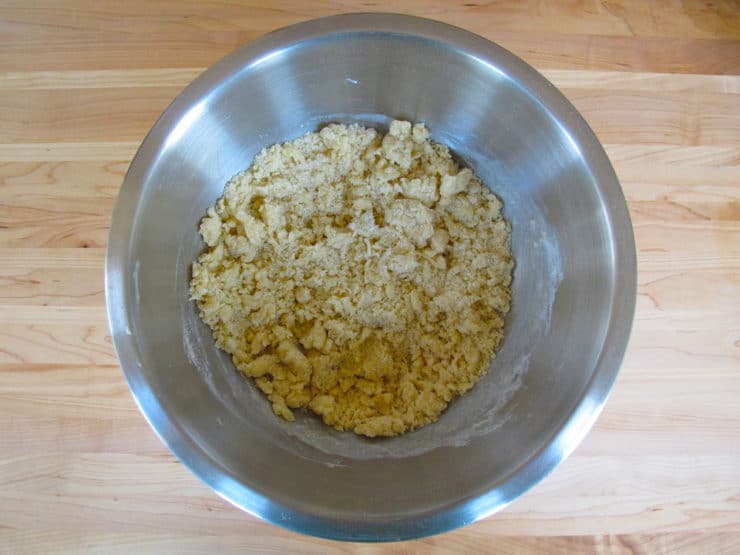
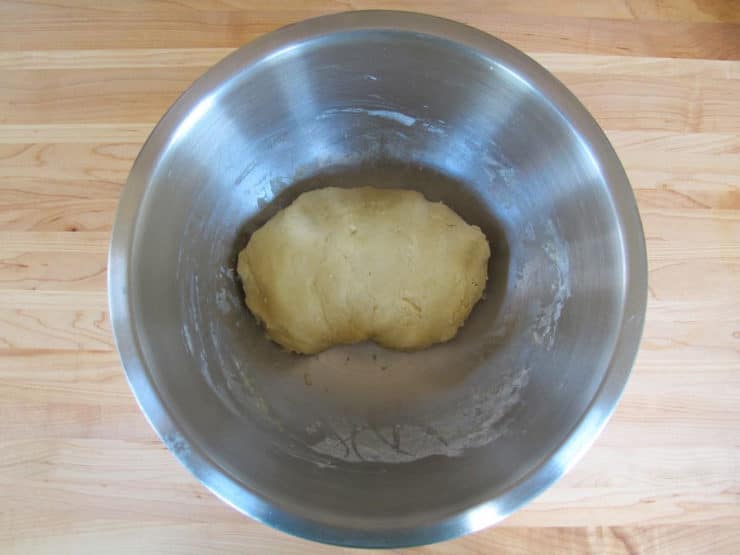
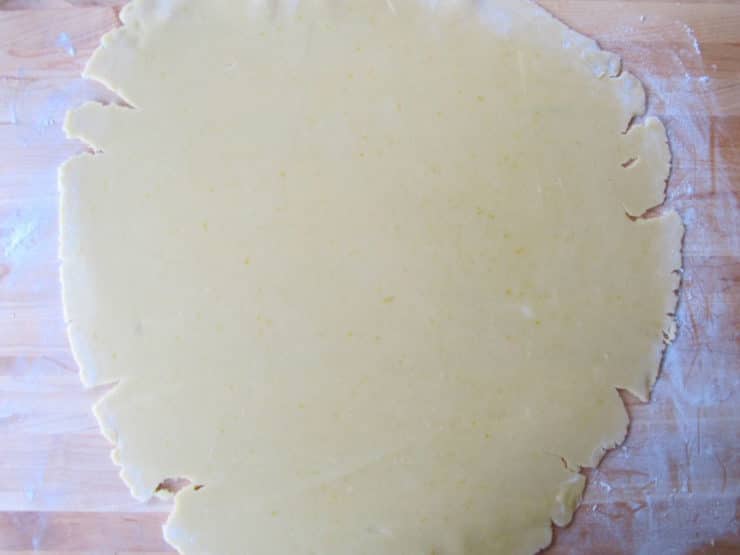
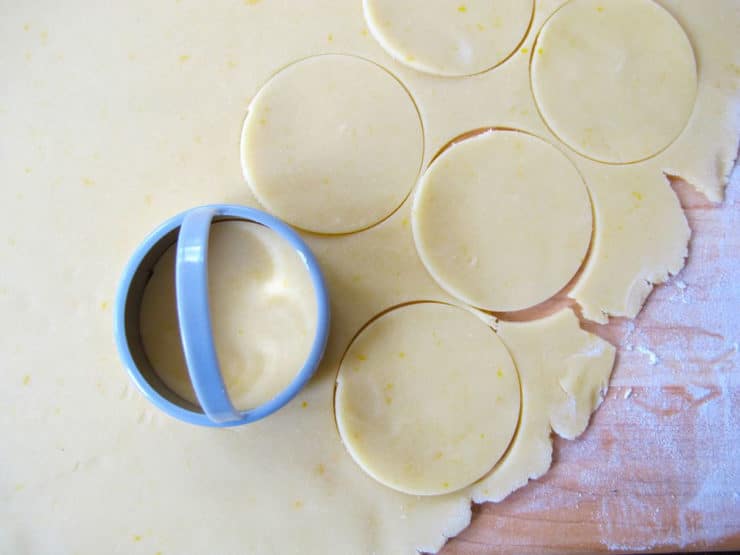
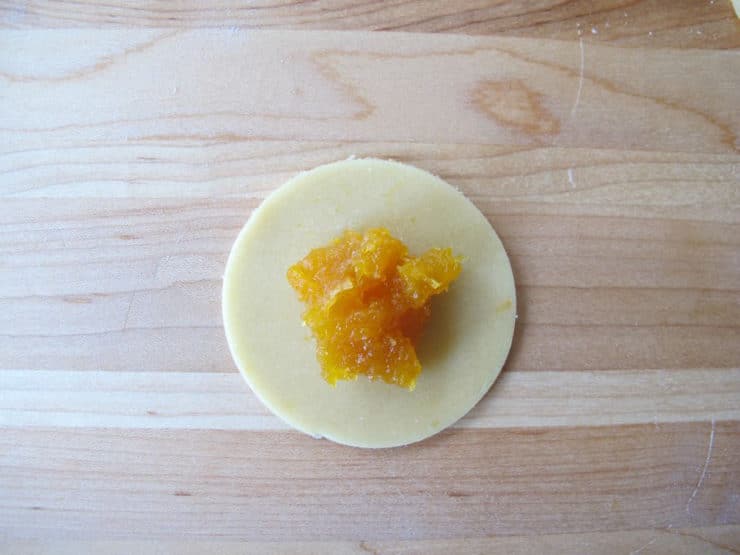
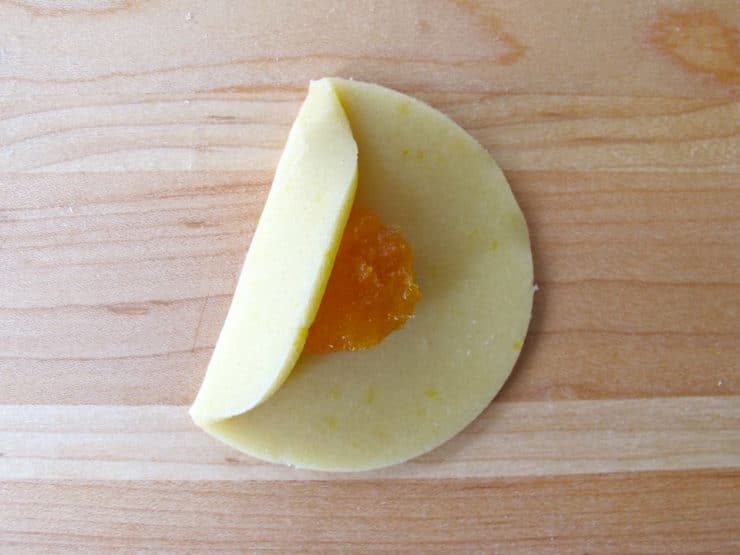

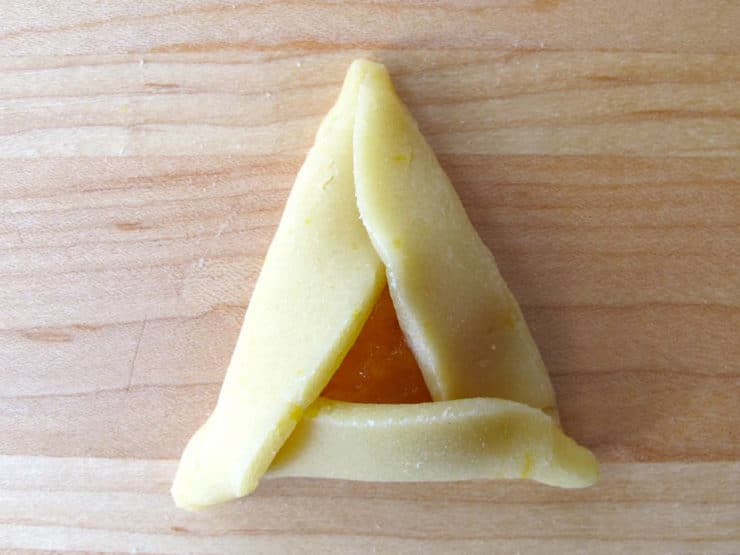

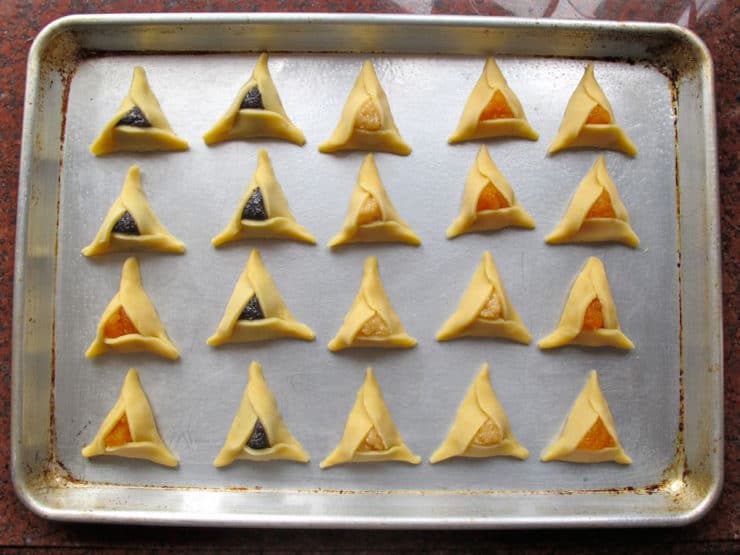
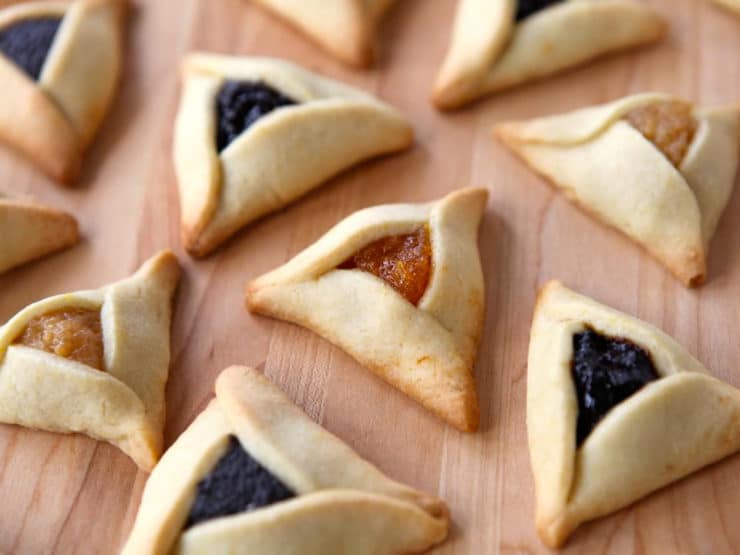


Very frustrating that I cannot email to myself. I did get the free cookbook, but the recipe I want isn’t included. I feel misled.
Hi NKD, sorry you feel that way. When you click “Email Me Recipes,” the popup clearly states what you will be getting in your email– there is no intention to mislead anybody. However, I will keep this feedback in mind for future design adjustments.
Has anyone ever tried using coconut sugar in the dough instead of white? Or a mixture? I’m almost out of white sugar and also would like to make them slightly lower glycemic. But I’m also making my next batch gluten free, which I’ve done before. Any thoughts on how they might change? Thanks.
I made the dough this afternoon then the kids came over. I didn’t roll and fill until tonight. Worked beautifully. Can’t wait to give Shalach Manot & enjoy on Purim!
Love love this recipe – it’s a real winner!
In Israel there’s a new fad of salty hamentschen – filled with veggies/ salty cheese /beef. (Sometimes they make them colorful with vegetable powder too) I was wondering if this recipe could be adapted to a saltier version? Just omitting the sugar could change the texture I believe.
Thanks soo much!!
Hi Abby! So glad you’re enjoying the recipe. I have not made this without the sugar, I would want to test the dough before advising you on this. The savory trend with hamantaschen is so interesting. If you end up trying it, I wish you good luck!
Can this be made gluten free for instance with Bobs Red Mill 1 to 1 flour?
I have 2 grandchildren who are gluten and dairy free. I’d like to make this recipe for them. I realize a bit more gluten free flour must be used than regular flour.
Thank you,
Jill Auerbach
Hi Jill! I have tried these with gluten free 1 to 1 flour and have not had good results. However, some readers have played around with it and commented their modifications, which they said worked well. You may wish to read through the comments to see what they suggest! I do want to test a gluten free version of this recipe, but haven’t had a chance to do so in the past few years. Hopefully next year!
I just made these on the weekend using Presidents Choice Gf 1-1 flour, which has xanthum gum, and they were perfect!! And I found the dough actually easier to work with them the regular version.
Great tip Shayla, thank you!
Hi, can you freeze these cookies once they’re prepared?
Also, can you freeze the dough in advance?
Thank you!
Hi Katherine, the finished cookies can be frozen, yes. However I don’t recommend making this dough ahead and freezing — it doesn’t work well. The butter version of this recipe can be frozen ahead.
Hi, can the dough be made in advance?
I do not recommend making this dough in advance.
Can the dough be made ahead of time and refrigerated before rolling and filling? I am making hamentashen with toddlers so want to have everything prepared ahead of time and just skip to the rolling and filling part with them. Will rate after I bake them.
Hi, that should be fine, but I wouldn’t recommend refrigerating for longer than a few hours with this particular dough.
Will this dough hold up if made ahead and chilled for a day?
I would only chill this dough for 3-4 hours, at most, as it tends to dry out quickly unlike the buttery dough recipe on this site.
This is hands down the most foolproof recipe for hamantaschen. Even when I make a double batch, the dough remains perfect while waiting in the bowl. You will need to add a little flour for rolling it out. The dough pinches great, too. My favorite new filling is lemon curd. Happy Purim!
I’ve made this in years past and they were easy.
Wondering if you can store this dough overnight?
I do not recommend chilling this dough for more than 3-4 hours, as it can tend to get dry.
Great recipe! I make these vegan by whisking together 30 grams of chickpea flour and 1/2 cup orange juice in place of the eggs. They really are a lot easier than other recipes I’ve tried and the hamantaschen come out looking great.
Perfect recipe! Followed exactly as written and these turned out beautifully. I was able to make 35 cookies with just a little bit of dough scraps left over.
Did you let the dough rest and chill before rolling it out?
Not for this recipe, a rest is not needed.